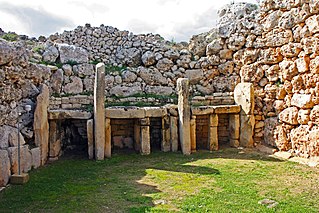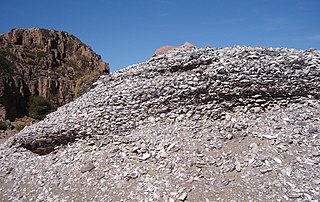 W
WThe Stone Age was a broad prehistoric period during which stone was widely used to make tools with an edge, a point, or a percussion surface. The period lasted for roughly 3.4 million years, and ended between 8,700 BCE and 2,000 BCE, with the advent of metalworking. Though some simple metalworking of malleable metals, particularly the use of gold and copper for purposes of ornamentation, was known in the Stone Age, it is the melting and smelting of copper that marks the end of the Stone Age. In western Asia this occurred by about 3,000 BCE, when bronze became widespread. The term Bronze Age is used to describe the period that followed the Stone Age, as well as to describe cultures that had developed techniques and technologies for working copper into tools, supplanting stone in many uses.
 W
WThis is a descriptive list of Stone Age art, the period of prehistory characterised by the widespread use of stone tools. This page contains, by sheer volume of the artwork discovered, a very incomplete list of the works of the painters, sculptors, and other artists who created what is now called prehistoric art. For fuller lists see Art of the Upper Paleolithic, Art of the Middle Paleolithic, and Category:Prehistoric art and its many sub-categories.
 W
WA circular rampart is an embankment built in the shape of a circle that was used as part of the defences for a military fortification, hill fort or refuge, or was built for religious purposes or as a place of gathering.
 W
WConchoidal fracture describes the way that brittle materials break or fracture when they do not follow any natural planes of separation. Mindat.org defines conchoidal fracture as follows: "a fracture with smooth, curved surfaces, typically slightly concave, showing concentric undulations resembling the lines of growth of a shell". Materials that break in this way include quartz, chert, flint, quartzite, jasper, and other fine-grained or amorphous materials with a composition of pure silica, such as obsidian and window glass, as well as a few metals, such as solid gallium.
 W
WIn archeology, a denticulate tool is a stone tool containing one or more edges that are worked into multiple notched shapes, much like the toothed edge of a saw. Such tools have been used as saws, more likely for meat processing than for wood. It is possible, however, that some or all of these notches were used for smoothing wooden shafts or for similar purposes.
 W
WIn archaeology and anthropology, a digging stick, or sometimes yam stick, is a wooden implement used primarily by subsistence-based cultures to dig out underground food such as roots and tubers or burrowing animals and anthills. The stick may also have other uses in hunting or general domestic tasks.
 W
WIn archaeology, the term entoptic phenomena relates to visual experiences derived from within the eye or brain. In this respect they differ slightly from the medical definition, which defines entoptic phenomena as only applying to sources within the eye, not the brain. To avoid this confusion, the term subjective visual phenomena is sometimes used. Entoptic was chosen by author David Lewis-Williams due to its origin from Greek meaning "coming from within".
 W
WA hunter-gatherer is a nomadic human living in a society in which most or all food is obtained by foraging. Hunter-gatherer societies stand in contrast to agricultural societies, which rely mainly on domesticated species, although the boundaries between the two are not distinct.
 W
WLindley is a small town situated on the banks of the Vals River in the eastern region of the Free State province of South Africa. It was named after an American missionary, Daniel Lindley, who was the first ordained minister to the Voortrekkers in Natal.
 W
WIn archaeology, a lithic core is a distinctive artifact that results from the practice of lithic reduction. In this sense, a core is the scarred nucleus resulting from the detachment of one or more flakes from a lump of source material or tool stone, usually by using a hard hammer percussor such as a hammerstone. The core is marked with the negative scars of these flakes. The surface area of the core which received the blows necessary for detaching the flakes is referred to as the striking platform. The core may be discarded or shaped further into a core tool, such as can be seen in some types of handaxe.
 W
WIn archaeology, a lithic flake is a "portion of rock removed from an objective piece by percussion or pressure," and may also be referred to as a chip or flake, or collectively as debitage. The objective piece, or the rock being reduced by the removal of flakes, is known as a core. Once the proper tool stone has been selected, a percussor or pressure flaker is used to direct a sharp blow, or apply sufficient force, respectively, to the surface of the stone, often on the edge of the piece. The energy of this blow propagates through the material, often producing a Hertzian cone of force which causes the rock to fracture in a controllable fashion. Since cores are often struck on an edge with a suitable angle (x<90°) for flake propagation, the result is that only a portion of the Hertzian cone is created. The process continues as the flintknapper detaches the desired number of flakes from the core, which is marked with the negative scars of these removals. The surface area of the core which received the blows necessary for detaching the flakes is referred to as the striking platform.
 W
WA megalith is a large pre-historic stone that has been used to construct a structure or monument, either alone or together with other stones. There are over 35,000 in Europe alone, located widely from Sweden to the Mediterranean sea.
 W
WMicroblade technology is a period of technological development marked by the creation and use of small stone blades, which are produced by chipping silica-rich stones like chert, quartz, or obsidian. Blades are a specialized type of lithic flake that are at least twice as long as they are wide. An alternate method of defining blades focuses on production features, including parallel lateral edges and dorsal scars, a lack of cortex, a prepared platform with a broad angle, and a proximal bulb of percussion. Microblades are generally less than 50 mm long in their finished state.
 W
WA midden is an old dump for domestic waste which may consist of animal bone, human excrement, botanical material, mollusc shells, sherds, lithics, and other artifacts and ecofacts associated with past human occupation.
 W
WIn archaeological terms, a projectile point is an object that was hafted to weapon that was capable of being thrown or projected, such as a spear, dart, or arrow, or perhaps used as a knife. They are thus different from weapons presumed to have been kept in the hand, such as axes and maces, and the stone mace or axe-heads often attached to them.
 W
WThe Stone Age Institute is an independent research center dedicated to the archaeological and paleontological study of human origins and technological development beginning with the earliest stone tools. The institute was founded by archaeologists Nicholas Toth and Kathy Schick to provide a focal point for research on human origins where affiliated scientists could collaborate on research and to provide science education outreach on human origins and evolution. The Stone Age Institute is a 501(c)(3) nonprofit organization.
 W
WA trilithon is a structure consisting of two large vertical stones (posts) supporting a third stone set horizontally across the top (lintel). It is commonly used in the context of megalithic monuments. The most famous trilithons are those of Stonehenge in England, those found in the Megalithic temples of Malta—both of which are UNESCO World Heritage Sites—and the Osireion in Egypt.
 W
WUncontacted peoples are communities or groups of indigenous peoples living without sustained contact to neighbouring communities and the world community, and includes "indigenous peoples in voluntary isolation". In 2013 there were thought to be roughly 100 uncontacted tribes worldwide, half of whom live in the Amazon rainforest.